Roasted Spatchcock Turkey
Roasted Spatchcock Turkey made with a whole turkey butterflied and seasoned with fresh herbs and butter, then roasted until juicy on the inside and crispy on the outside, ready in under 2 hours!
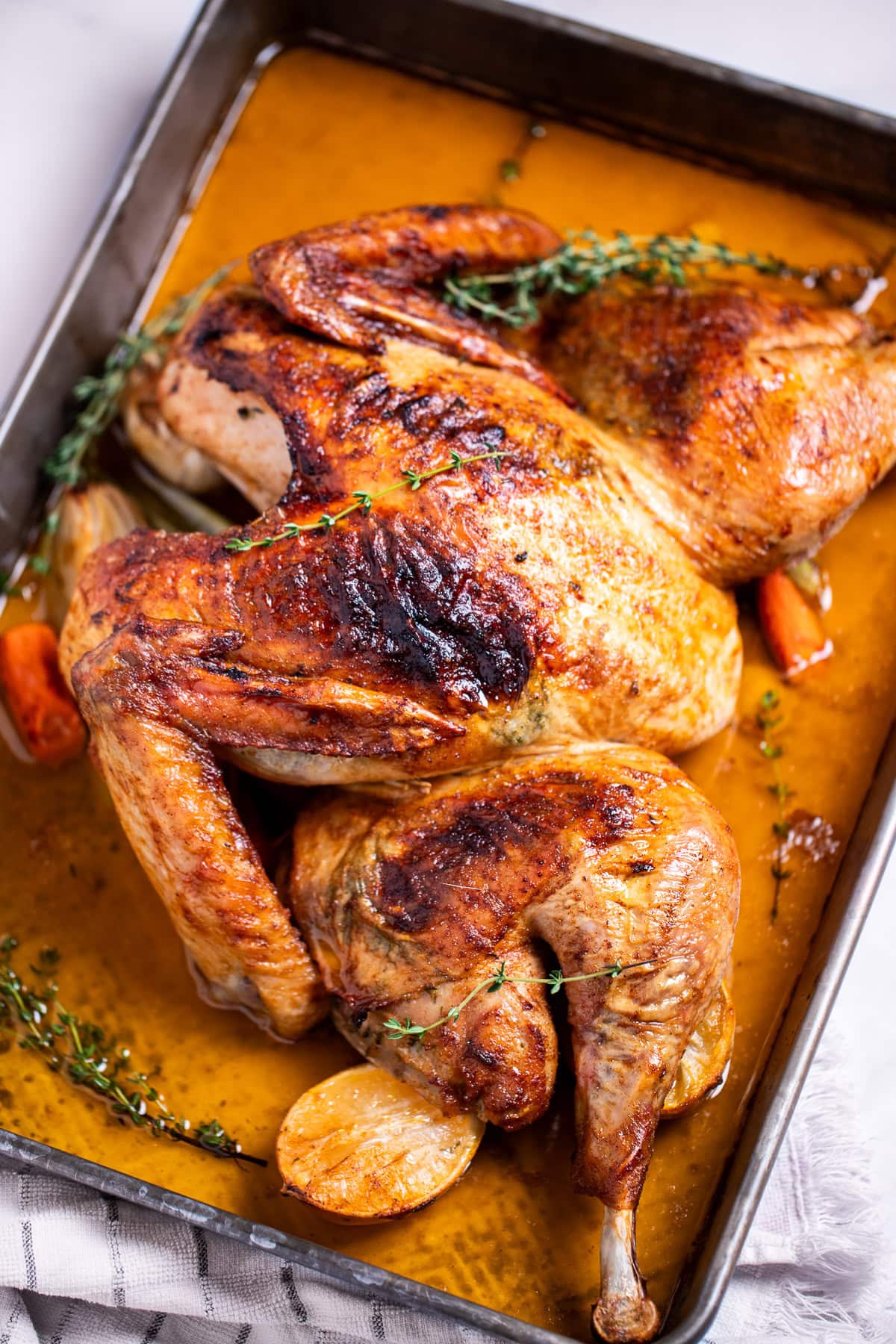
Roasted Spatchcock Turkey is one of my family’s favorite things to make for Thanksgiving Day or Christmas, because it’s so flavorful, juicy, and the skin turns out extra crispy! I like to throw some veggies on the bottom to flavor the pan drippings for gravy later.
The best part about a spatchcocked turkey is that it will cook more evenly than with traditional cooking methods, because we can roast it at a higher cooking temperature. Everything finishes cooking at the same time, giving you more tender and less dry meat!
If you’d like some more holiday main course recipes, check out my Slow Cooker Spiral Ham, or my Sausage Stuffed Acorn Squash!
Table of contents
Why You’ll Love This Recipe
Faster Cooking Time – If you don’t want to spend the entire day roasting a whole turkey, then the spatchcock cooking method will cut your time down significantly! A 10-12 pound bird will take about 2 hours from start to finish, including prep time.
Juicy Meat That Cooks Evenly – Because we’re flattening the spatchcocked turkey, the breast and leg meat has a chance to roast evenly and finish cooking at the same time, making sure the meat stays tender and juicy.
More Oven Space – This won’t take up as much room as a traditional turkey height-wise, so you could fit more on the other racks in the oven.
Ingredients You’ll Need
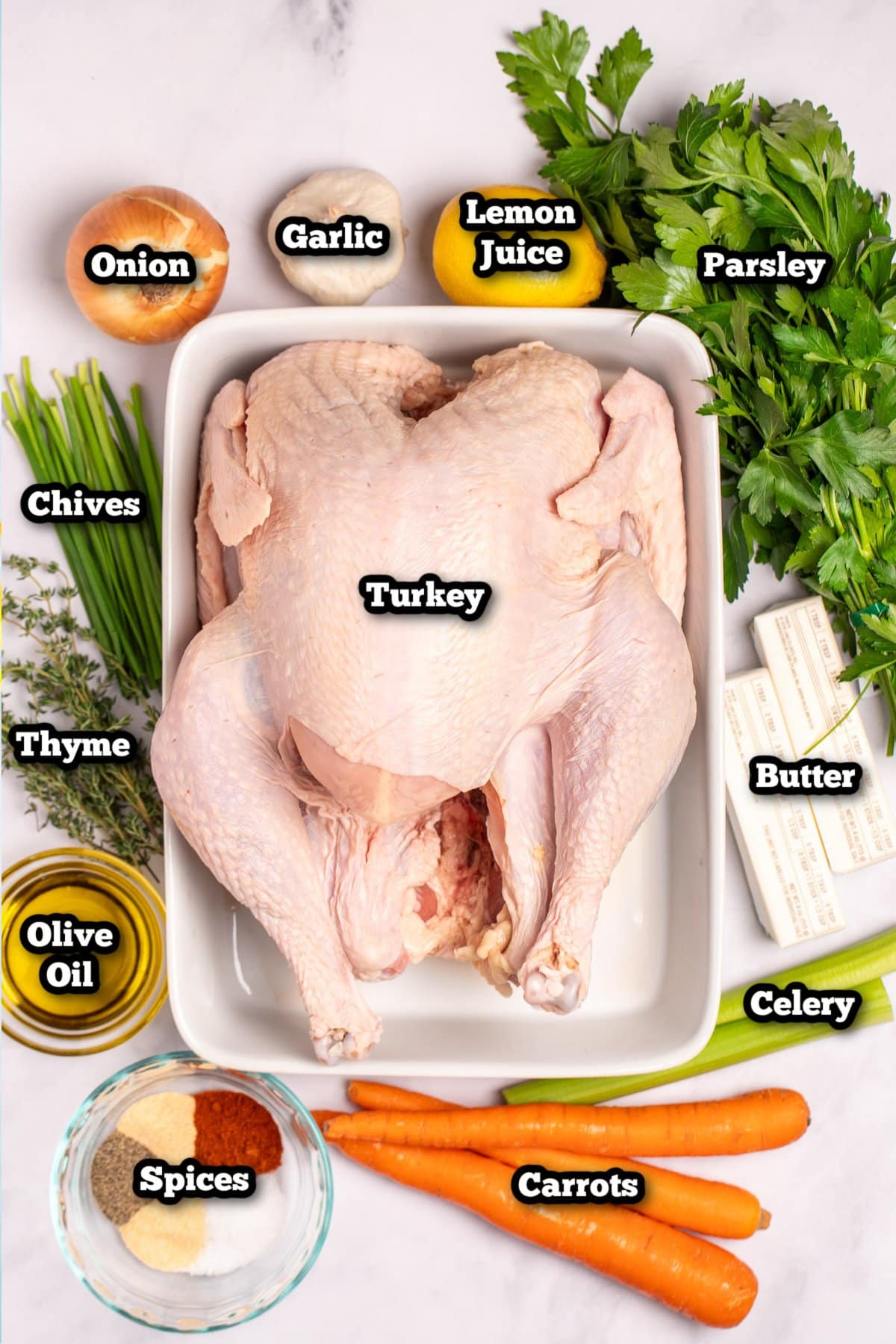
Whole Turkey. For this recipe, you want to buy a whole turkey.
The amount of time this will take to cook will depend on how big of a turkey you have. I used a 10 pound turkey, and it took about 90 minutes for it to finish cooking.
Butter. Use unsalted butter to add moisture and flavor to the meat. Let it soften at room temperature for a short amount of time, then mix with the herbs for flavor.
Lemon Juice. This adds a bright fresh flavor to the compound butter and balances out the savory notes.
Extra Virgin Olive Oil. While we’re using butter under the skin, you need to use olive oil on the outside of the bird. This helps keep the butter from burning, and makes the skin really crispy.
Herbs. You can mix it up, but I like to use a combination of fresh parsley, fresh chives, and fresh thyme leaves.
Garlic. I like to use minced garlic in the compound butter, and I’m also using a whole bulb of garlic under the turkey while it’s roasting. When you make gravy, you can puree the roasted garlic right into it for an amazing flavor!
Spices. The spices will be mixed with the olive oil to make a really nice flavorful crispy turkey skin.
I like to use a combination of onion powder, garlic powder, paprika, kosher salt, and black pepper.
Veggies. Here’s the trick – use vegetables to prop up your turkey instead of a wire rack. It’s less equipment, less dishes to wash, and more flavor!
Kitchen Tools
For this recipe you’ll need a large roasting pan, a large cutting board, and a sharp pair of kitchen shears or a sharp chef’s knife.
How to Spatchcock A Turkey

Preheat the oven to 450°F. Add the butter, fresh herbs, lemon juice, and minced garlic to a food processor.
Pulse until everything is combined and set aside. In another small bowl, whisk together the spices and olive oil and set aside.

Place the turkey on the cutting board back-side-up. Make sure to remove any giblets or neck pieces from the cavity and discard.
Use the kitchen scissors to cut along one side of the spine. You are cutting through the rib bones, and it may take some strength to do it.
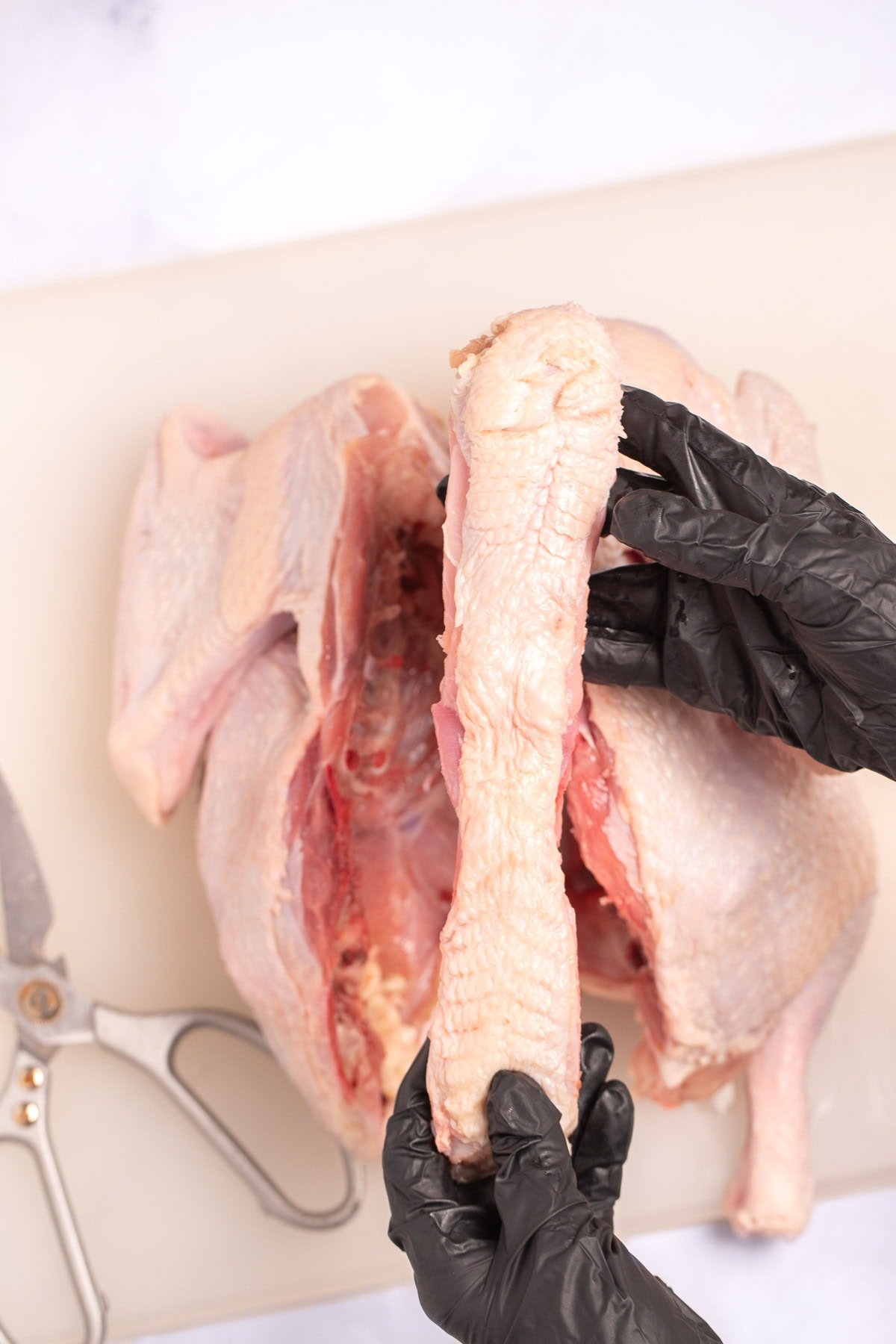
When one side is done, cut along the other side until you can remove the spine completely and discard.
Use a paper towel to absorb any liquid in the turkey cavity and discard. Then flip the turkey over to breast-side-up. Pat the turkey dry with a fresh paper towel.
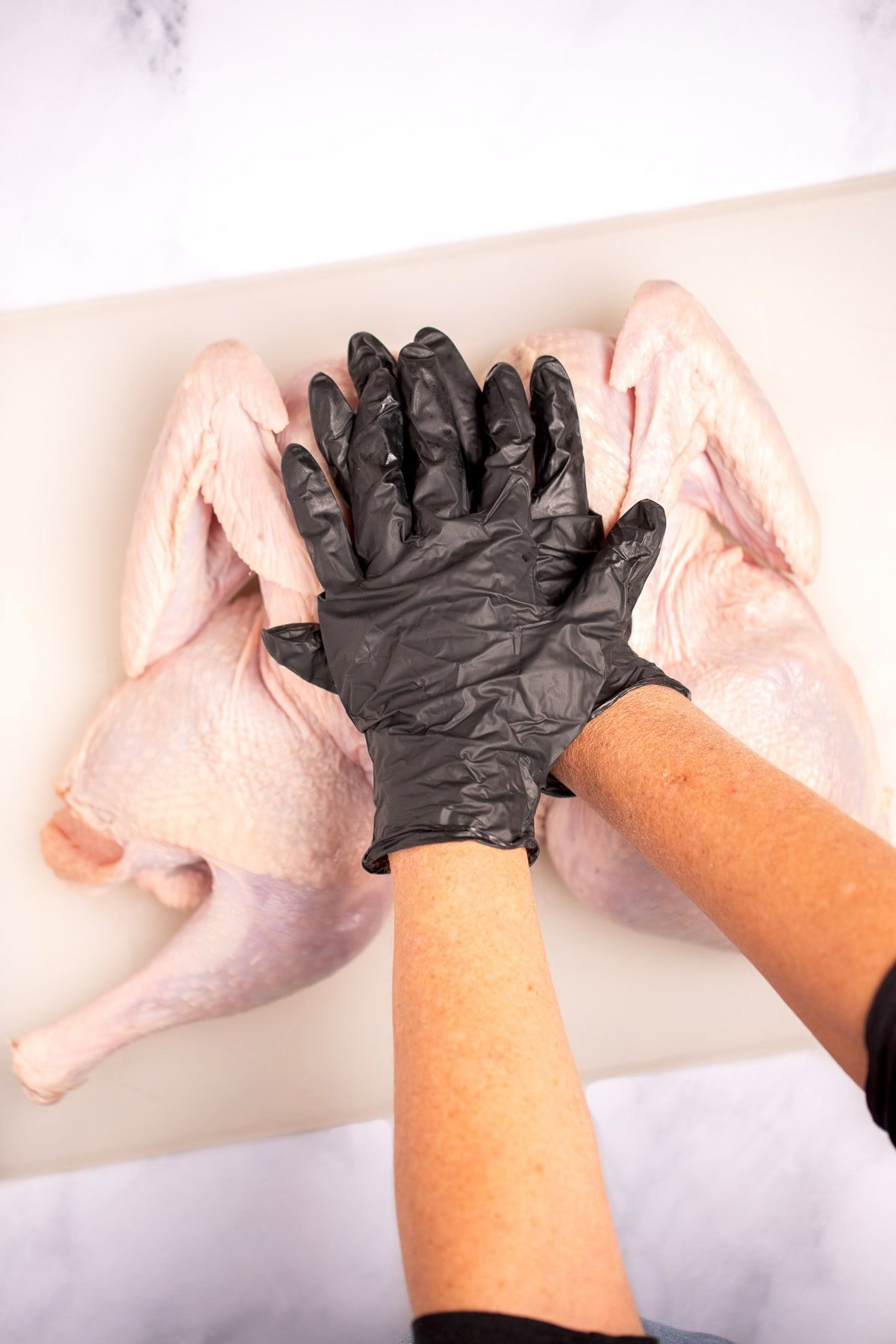
Place your hands on top of the middle of the turkey breast. Push down until you hear a crack, and the turkey is laying mostly flat on the board.
Turn the leg pieces until they face out and lay flat on the cutting board, too.

Place the vegetables and garlic clove (open-side-up) on the bottom of the roasting pan. Place the turkey on top, breast-side-up. Adjust any of the vegetables to make sure the turkey isn’t touching the bottom of the pan, and tuck the turkey wings in.
From here, use your fingers to make space between the skin on the turkey breast and legs. Go slowly and separate the skin gently so it doesn’t tear.

Make a 2-3 inch ball of the compound butter and place it under the skin on one side of the turkey breast. Hold the skin opening down, and use your other hand to spread the butter by gently pressing down on it.
Repeat for the other turkey breast and the leg sections until the butter is all used.
Pour the olive oil mixture over the turkey skin. Use your hands to spread it evenly over the entire outside of the turkey.

Pour 1-2 cups of water on the bottom of the roasting pan, just enough to cover the bottom, and roast the turkey for 30 minutes.
After time is up, drop the oven temperature to 350°F and cook for an additional 60 minutes, or until the turkey is golden brown and reaches an internal temperature of 165°F on a meat thermometer, in the middle of the breast and leg sections.
Let the turkey rest out of the oven for 15 minutes before carving.
Recipe Variations
- For an even crispier skin, you can try dry brining the turkey before you cook it.
- Try adding lemon or orange zest to the compound butter along with citrus slices under the skin while roasting to give it a nice bright flavor.
- Make this spicy with some red pepper flakes in the compound butter and cayenne pepper in the seasoning mixture, along with some chipotle seasoning, chili powder, cumin, and smoked paprika.
- Save the turkey bones in the refrigerator to make turkey stock the next day!
- If you want a budget-friendly option, you can use this same recipe for a roast chicken. Just make about half of the butter and seasoning, and roast uncovered at 425°F for about 45 minutes for a 4-5 pound bird.
Recipe Tip! When you drop the temperature down to 350°F, don’t open the oven door. It’ll come down to temperature naturally once you change the setting.
Frequently Asked Questions
There are benefits to dry brining a spatchcock turkey, like making the skin crispier, and adding a ton of flavor. But I usually don’t, just because I want to keep the sodium lower. However, if you did want to dry brine a spatchcock turkey, it’s pretty easy to do!
The night before, spatchcock your turkey and set it on a sheet pan lined with some paper towels. Just put a generous sprinkle of kosher salt (mixed with a small amount of baking soda) on the turkey skin and press it in gently with your hands. You can also add some dried herbs and spices, or wait and season the rest later. This will dry out the skin, which makes it crispier when roasted.
Refrigerate uncovered on the baking sheet until you’re ready to cook the next day. Then add your compound butter or additional seasoning, transfer the turkey from the baking sheet to a roasting pan, and roast. Don’t go too crazy with the salt, think of seasoning the turkey, not covering it completely. You don’t want it to be overly salty after cooking.
How to Make Turkey Gravy
- After the turkey comes out of the oven, pass the drippings through a fine-mesh strainer, and add additional chicken, vegetable, or turkey broth in a saucepan over medium-high heat. If you added a garlic bulb to the roasting pan, squeeze the roasted garlic cloves out first and mash them through the strainer for flavor.
- In a separate measuring cup, whisk a few tablespoons of cornstarch with some cold broth and stir it into the gravy. The golden rule is 1 tablespoon of cornstarch per cup of liquid in the gravy.
- Add any additional herbs and seasonings like rosemary leaves, turmeric, garlic powder, onion powder, or fresh thyme leaves. Whisk until it begins to thicken. Adjust with salt and pepper, then serve.
Recipe Tip! The olive oil on top of the skin helps keep the butter from burning if any of it comes out while it’s cooking. I’m also adding water to the bottom of the pan for the same reason, and to make sure we have enough liquid to make gravy later.
More Thanksgiving Recipes
- Slow Cooker Candied Sweet Potatoes
- Roasted Rainbow Carrots
- Creamy Sweet Potato Soup
- Sautéed Green Beans With Garlic
- Crockpot Sweet Potato Casserole
Storage
Refrigerate leftover Thanksgiving turkey for 3-4 days in an airtight container.
Carve the turkey into pieces first, because a whole turkey may take too long to cool down in the refrigerator. You can read more about Thanksgiving food safety here.
Freeze roasted turkey pieces for 2-3 months in a freezer-safe container.
Cooking Tips
- I’m using a 10-12 pound turkey for this recipe, if yours is larger you should plan on a longer cooking time. The cooking time will also depend on your oven temperature.
- You can use a wire rack on the roasting pan to hold the turkey up instead of resting it on top of the vegetables. I feel like that just creates more dishes to wash, and the veggies help add flavor to the turkey.
- If you don’t have kitchen scissors (the easiest method), you can use a sharp knife to cut through the turkey. Just be really careful, and don’t work with dull knives because they cause more accidents.
- You’re cutting through to rib bones, so you might have to use some strength for this part.
- Check on your roast turkey around the one hour mark. If the skin is getting too dark, you can top it with some aluminum foil to prevent it from burning while it finishes cooking.
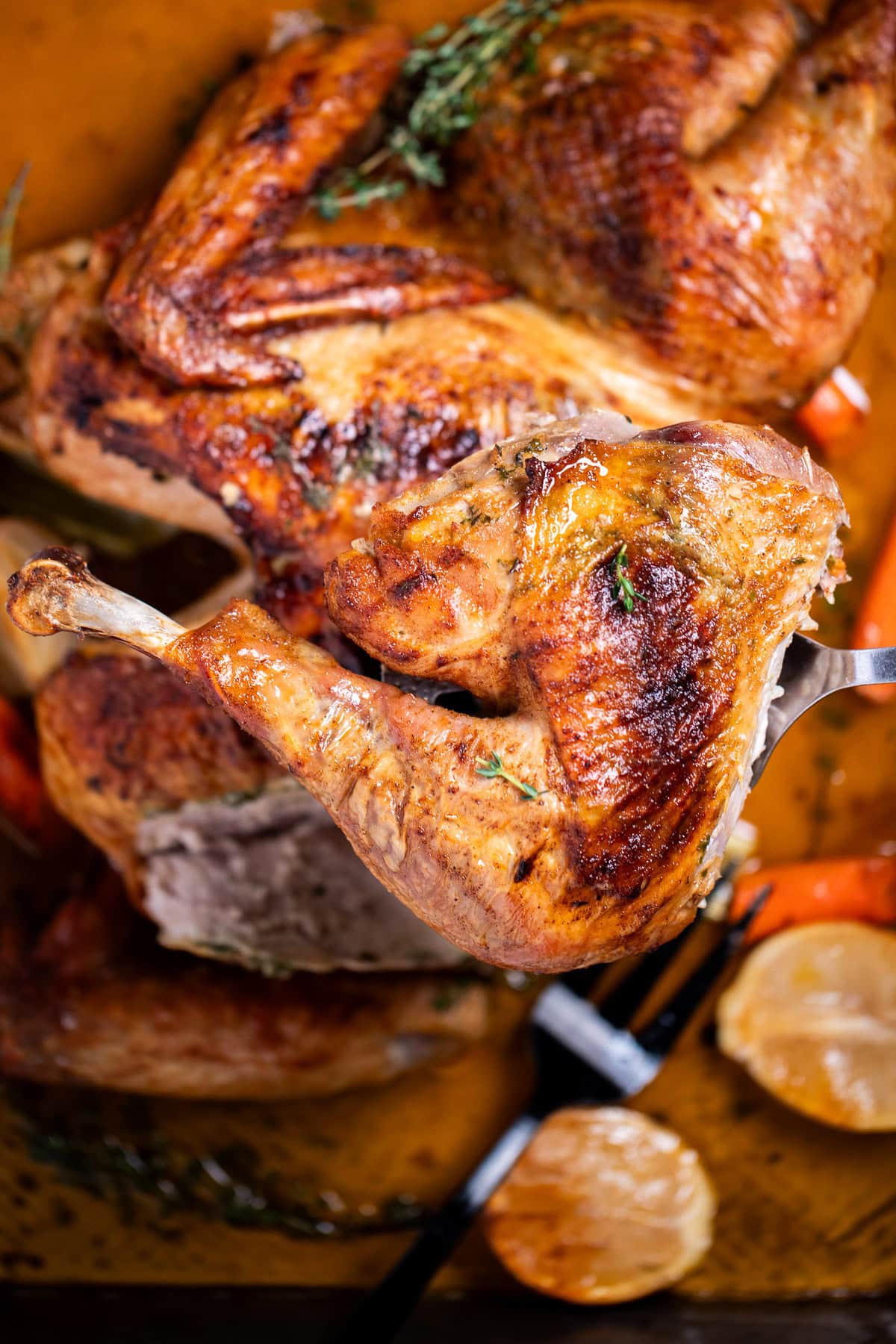
Tried this recipe? ⭐ Leave a review and share what worked best for you—your tips help other home cooks get the same delicious results!
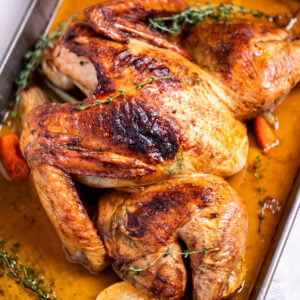
Roasted Spatchcock Turkey
Ingredients
- 10 pound whole turkey, giblets and neck removed from cavity
- 1 medium Vidalia onion, peeled and quartered
- 2 medium celery ribs, cut into pieces
- 2 medium carrots, cut into pieces
- 1 medium garlic bulb, top cut off and discarded
- 1 medium lemon, cut in half lengthwise
Compound Butter
- 1 cup unsalted butter, softened
- 2 tablespoons fresh parsley, roughly chopped
- 2 tablespoons fresh chives, roughly chopped
- 1 tablespoon fresh thyme, leaves only
- 2 cloves garlic, minced
- 1 tablespoon lemon juice
Seasoning Mixture
- 3 tablespoons extra virgin olive oil
- 1 teaspoon onion powder
- 1 teaspoon garlic powder
- 1 teaspoon paprika
- 1 teaspoon kosher salt, or to taste
- 1 teaspoon black pepper, or to taste
Equipment
- 1 large roasting pan
- 1 large cutting board
- 1 pair of sharp kitchen scissors
Instructions
- Preheat the oven to 450°F. Set the roasting pan aside for now.
Prep the Compound Butter and Seasoning
- Add the butter, fresh herbs, lemon juice, and minced garlic to a food processor. Pulse until everything is combined and set aside.
- In another small bowl, whisk together the spices and olive oil and set aside.
Spatchcock the Turkey
- Place the turkey on the cutting board back-side-up. Use the kitchen scissors to cut along one side of the spine. You are cutting through the rib bones, this might take some strength.
- When one side is done, cut through the other side until you can remove the spine completely and discard. Use a paper towel to absorb any liquid in the turkey cavity and discard. Flip the turkey over and pat the turkey breast dry with another paper towel.
- Place your hands on top of the middle of the turkey breast and push down until you hear a crack, and the turkey is laying mostly flat. Turn the leg pieces to face out.
Season the Turkey
- Place the vegetables and garlic clove (open-side-up) on the bottom of the roasting pan. Place the turkey on top, breast-side-up. Adjust any of the vegetables to make sure the turkey isn't touching the bottom of the pan, and tuck the turkey wings in.
- From here, use your fingers to make space between the skin on the turkey breast and legs. Go slowly and separate the skin gently so it doesn't tear.
- Make a 2-3 inch ball of the compound butter and place it under the skin on one side of the turkey breast. Hold the skin opening down, and use your other hand to spread the butter by gently pressing down on it. Repeat for the other turkey breast and the leg sections until the butter is all used.
- Pour the olive oil and spice mixture over the turkey skin. Use your hands to spread it evenly over the entire outside of the turkey.
Roast the Turkey
- Pour 1-2 cups of water on the bottom of the roasting pan, and roast the turkey uncovered for 30 minutes.
- After time is up, drop the oven temperature to 350°F and cook for an additional 60 minutes, or until the turkey is golden brown and reaches an internal temperature of 165°F on a meat thermometer, in the most center part of the breast and leg sections.
- If the turkey skin gets too dark before the meat is done cooking, you can cover it with aluminum foil so it doesn't burn. When the turkey is done cooking, take it out of the oven and let it rest for 15 minutes before carving.
Notes
- When you drop the temperature down to 350°F, don’t open the oven door. It’ll come down to temperature naturally once you change the setting.
- I’m using a 10-12 pound turkey for this recipe, if yours is larger you should plan on a longer cooking time. The cooking time will also depend on your oven temperature.
- You can use a wire rack on top of the roasting pan to hold the turkey up instead of resting it on top of the vegetables. I feel like that just creates more dishes to wash, and the veggies help add flavor to the turkey.
- If you don’t have kitchen scissors (the easiest method), you can use a sharp knife to cut through the turkey. Just be really careful, and don’t work with dull knives because they cause more accidents.
- The olive oil on top of the skin helps keep the butter from burning if any of it comes out while it’s cooking. I’m also adding water to the bottom of the pan for the same reason, and to make sure we have enough liquid to make gravy later.
Nutrition
We are a participant in both the RewardStyle and Amazon Services LLC Associates Program, which are affiliate advertising programs designed to provide a means for sites to earn advertising fees by advertising and linking to amazon.com and through RewardStyle.


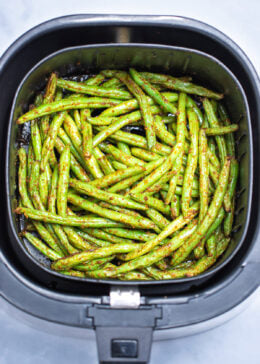
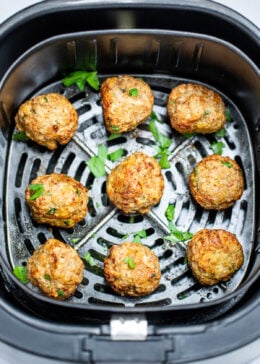





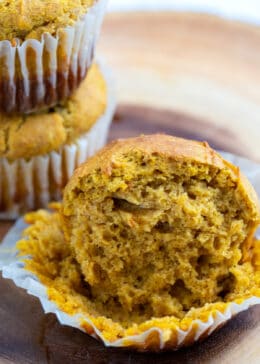
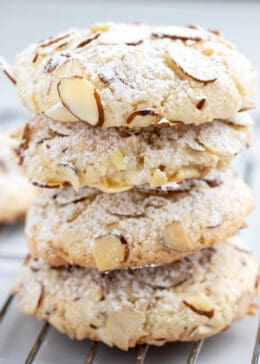
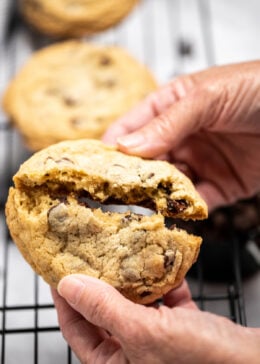

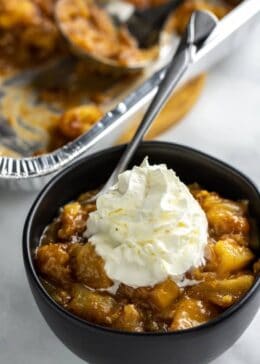



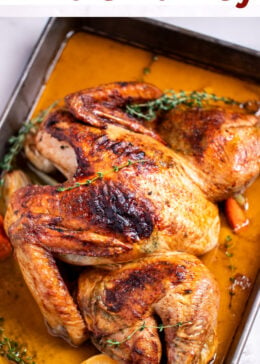

I add the vegetables that were roasted under the turkey to the gravy. I then use an immersion blender to blend them into the stock on the stove. Next I finish thickening the gravy. Often I don’t need to because the vegetables have thickened it.
That’s a great idea to use the immersion blender, I’m going to try it!